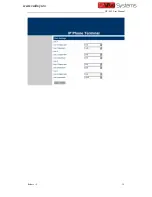
Release 1.2
30
1.
RTP Port (range)
– Audio stream is transmitted via Real Time Protocol (RTP) and
at least 4 ports are used per voice channel. The default port range is 16384 –
32768. Specify the port range depending on your network environment if
needed.
2.
Packet length (ms)
– This specify the length of a voice packet. The default
packet length is 20 ms.
3.
Jitter Buffer Mode
–
Three jitter modes are available. The
Fixed Mode
, which
is the default mode, is a simple first in first out mode, with a fixed jitter buffer
delay. By definition the jitter buffer depth is twice the jitter buffer delay. The
Sequential Mode
is also a fixed jitter buffer delay mode, but in this mode the
jitter buffer function looks at the packet timestamp for dropped or out of
sequence packet problems. The data packets are sorted based on the packet
timestamp. The
Adaptive Mode
optimizes the size of the jitter buffer delay
and depth in response to network conditions, in addition to the sequential
mode.
4.
Media QoS
– QoS is also available for Media packets to improve voice quality.
This is rather significant in a network environment with large amount of data
traffics. Both
IP TOS
and
DiffServ
methods are supported.
5.
Media Encryption
– For secure voice transmission, RC4 / ET263 Encryption
methods are supported for the media channel. Please make sure your service
provider can support this encryption method before enabling this feature.
6.
Symmetric RTP
– Enable the media channel to use symmetric RTP ports.
Some network environment demand the use of Symmetric RTP.
7.
Media NAT Traversal
– NAT Traversal can be set independently for Media
packets. This gives a more flexible setting for various network environment.
Three modes are supported:
STUN(RFC 3489)
,
Port-forward/DMZ
, and
Relay
Proxy
.
www.vaidsys.ru
HT-842 User Manual










































